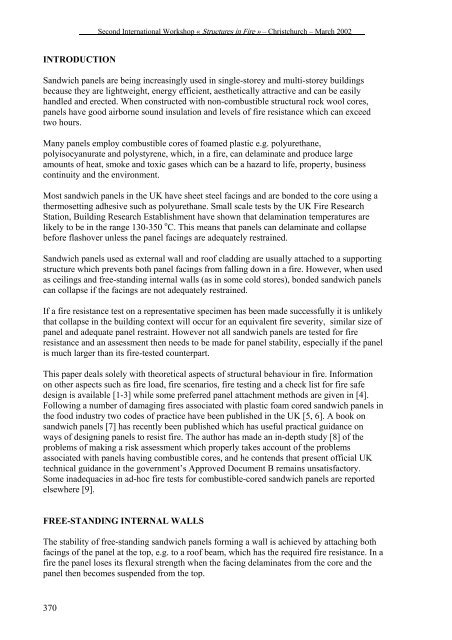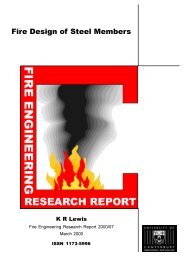stability of lightweight structural sandwich panels exposed to fire
stability of lightweight structural sandwich panels exposed to fire
stability of lightweight structural sandwich panels exposed to fire
You also want an ePaper? Increase the reach of your titles
YUMPU automatically turns print PDFs into web optimized ePapers that Google loves.
Second International Workshop « Structures in Fire » – Christchurch – March 2002<br />
INTRODUCTION<br />
Sandwich <strong>panels</strong> are being increasingly used in single-s<strong>to</strong>rey and multi-s<strong>to</strong>rey buildings<br />
because they are <strong>lightweight</strong>, energy efficient, aesthetically attractive and can be easily<br />
handled and erected. When constructed with non-combustible <strong>structural</strong> rock wool cores,<br />
<strong>panels</strong> have good airborne sound insulation and levels <strong>of</strong> <strong>fire</strong> resistance which can exceed<br />
two hours.<br />
Many <strong>panels</strong> employ combustible cores <strong>of</strong> foamed plastic e.g. polyurethane,<br />
polyisocyanurate and polystyrene, which, in a <strong>fire</strong>, can delaminate and produce large<br />
amounts <strong>of</strong> heat, smoke and <strong>to</strong>xic gases which can be a hazard <strong>to</strong> life, property, business<br />
continuity and the environment.<br />
Most <strong>sandwich</strong> <strong>panels</strong> in the UK have sheet steel facings and are bonded <strong>to</strong> the core using a<br />
thermosetting adhesive such as polyurethane. Small scale tests by the UK Fire Research<br />
Station, Building Research Establishment have shown that delamination temperatures are<br />
likely <strong>to</strong> be in the range 130-350 o C. This means that <strong>panels</strong> can delaminate and collapse<br />
before flashover unless the panel facings are adequately restrained.<br />
Sandwich <strong>panels</strong> used as external wall and ro<strong>of</strong> cladding are usually attached <strong>to</strong> a supporting<br />
structure which prevents both panel facings from falling down in a <strong>fire</strong>. However, when used<br />
as ceilings and free-standing internal walls (as in some cold s<strong>to</strong>res), bonded <strong>sandwich</strong> <strong>panels</strong><br />
can collapse if the facings are not adequately restrained.<br />
If a <strong>fire</strong> resistance test on a representative specimen has been made successfully it is unlikely<br />
that collapse in the building context will occur for an equivalent <strong>fire</strong> severity, similar size <strong>of</strong><br />
panel and adequate panel restraint. However not all <strong>sandwich</strong> <strong>panels</strong> are tested for <strong>fire</strong><br />
resistance and an assessment then needs <strong>to</strong> be made for panel <strong>stability</strong>, especially if the panel<br />
is much larger than its <strong>fire</strong>-tested counterpart.<br />
This paper deals solely with theoretical aspects <strong>of</strong> <strong>structural</strong> behaviour in <strong>fire</strong>. Information<br />
on other aspects such as <strong>fire</strong> load, <strong>fire</strong> scenarios, <strong>fire</strong> testing and a check list for <strong>fire</strong> safe<br />
design is available [1-3] while some preferred panel attachment methods are given in [4].<br />
Following a number <strong>of</strong> damaging <strong>fire</strong>s associated with plastic foam cored <strong>sandwich</strong> <strong>panels</strong> in<br />
the food industry two codes <strong>of</strong> practice have been published in the UK [5, 6]. A book on<br />
<strong>sandwich</strong> <strong>panels</strong> [7] has recently been published which has useful practical guidance on<br />
ways <strong>of</strong> designing <strong>panels</strong> <strong>to</strong> resist <strong>fire</strong>. The author has made an in-depth study [8] <strong>of</strong> the<br />
problems <strong>of</strong> making a risk assessment which properly takes account <strong>of</strong> the problems<br />
associated with <strong>panels</strong> having combustible cores, and he contends that present <strong>of</strong>ficial UK<br />
technical guidance in the government’s Approved Document B remains unsatisfac<strong>to</strong>ry.<br />
Some inadequacies in ad-hoc <strong>fire</strong> tests for combustible-cored <strong>sandwich</strong> <strong>panels</strong> are reported<br />
elsewhere [9].<br />
FREE-STANDING INTERNAL WALLS<br />
The <strong>stability</strong> <strong>of</strong> free-standing <strong>sandwich</strong> <strong>panels</strong> forming a wall is achieved by attaching both<br />
facings <strong>of</strong> the panel at the <strong>to</strong>p, e.g. <strong>to</strong> a ro<strong>of</strong> beam, which has the required <strong>fire</strong> resistance. In a<br />
<strong>fire</strong> the panel loses its flexural strength when the facing delaminates from the core and the<br />
panel then becomes suspended from the <strong>to</strong>p.<br />
370
















